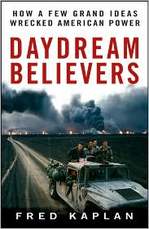Robert Parry explains how the United States became a Banana Republic.
A reader writes: “Thank you. Parry’s article is incisive in overview and on the mark in particulars. Excellent.” He continues:
One example of Parry’s thesis — that “sophisticated manipulation of information is what would do the Republic in” — is waterboarding being dismissively defined by journalistic leaders as “simulated drowning” rather than something like “repeated, forced drowning to near death.”
However, what I see as “sophisticated” in that context differs somewhat from Parry’s thesis: Much that is now classified and lamented as “sophisticated manipulation of information” is and used to be called “prevarication.”
My view is that “what would do the Republic in” is not so much the “sophisticated manipulation of information” as the orchestration (think Rove) of the large-scale, often very clever, sophistry that results in journalistic leaders buying the prevarications by treating them as fact and continually repeating them as fact.
For instance, the Nixon-era’s catchy but trivializing and dismissive term “Whitehouse horror story” is still with journalists who use the term “horror story” these days in place of “very serious violations” of criminal statutes, ratified treaties, or constitutional guarantees. Equating Abu Grab torture and “Animal House” is another example.
 The reader, who prefers not to be named, messaged again: “After sending my e-note commenting on Parry’s article, I realized that Phillip Carter’s article INTEL DUMP – ‘Daydream Believers’ (April 11, 2008, The Washington Post, a review of Fred Kaplan’s ‘Daydream Believers: How a Few Grand Ideas Wrecked American Power’) and an NPR excerpt from the book, supplement Parry’s article. They are two aspects of the mess that the same set of daydream believers have created (with the usually eager cooperation of Congress and the media).” He continues:
The reader, who prefers not to be named, messaged again: “After sending my e-note commenting on Parry’s article, I realized that Phillip Carter’s article INTEL DUMP – ‘Daydream Believers’ (April 11, 2008, The Washington Post, a review of Fred Kaplan’s ‘Daydream Believers: How a Few Grand Ideas Wrecked American Power’) and an NPR excerpt from the book, supplement Parry’s article. They are two aspects of the mess that the same set of daydream believers have created (with the usually eager cooperation of Congress and the media).” He continues:
As may become clear when you read Carter/Kaplan, configural theory was extremely unpopular with the daydream believers because it shows that new “transformational” weapons have in reality nothing like the capabilities they have in supposed scientific mathematical models that contravene physical theory, but are believed by the daydreamers (Rumsfeld, for instance) to scientifically confirm those nonexistent capabilities. What Parry’s article and Carter / Kaplan separately identify is synergistic.
As Carter notes: “Much of this faith is rooted in admiration of American military technology and the belief that the ‘revolution in military affairs’ enabled us to do anything we wanted in the world, with or without our allies, regardless of whoever opposed us. Kaplan walks us through this history, from the carpet bombing campaigns of World War II to the first precision-guided bombing of a bridge in North Vietnam to the Gulf War and its famous smart bomb videotapes to today’s wars in Iraq and Afghanistan.”
Thanks again for alerting me to Parry’s article.
Por nada. I should have mentioned the title he gave it: “Losing the War for Reality.”




